Like the Nation, The tax collection of the provinces was affected by the lower activity. In the first four months of the year The own income of 19 districts fell 5.9% real year-on-yearwhich in turn forced governments to deepen spending adjustments.
According to a report by the consulting firm Politikón Chaco, during the first quarter of 2024, provincial tax revenues totaled $7.5 billion. In January it had fallen 9.5% while in February, 3.4% and in March 2.2%.
Is about Buenos Aires, City of Buenos Aires, Córdoba, Santa Fe, Neuquén, Mendoza, Tucumán, Salta, Entre Ríos, Chubut, Río Negro, Chaco, Santa Cruz, San Luis, San Juan, Jujuy, Catamarca, Formosa and La Rioja.
“This decelerating process of the fall was interrupted in April, the month where the drop was 8.4%. Added to this is the fact thatIn December the real decrease was 12.7%, the strongest since June 2020 (-13.8%) month with impacts of the pandemic,” says Politikón Chaco.
reca-provinces-politikon.png
If the collection of the first quarter of 2024 is compared in constant currency Compared to the same period in 2022, there are also drops (-4.8%), as is also observed when comparing with the first four accumulated months of 2021 (-2.0%) and 2019 (-2.6%). On the other hand, collection is higher than that of the first quarter of 2020 (+11.2%).
Between Buenos Aires, CABA and Córdoba they explain 70% of the consolidated Of the nineteen jurisdictions analyzed, and adding Santa Fe, Neuquén and Mendoza, these five concentrate 85% of the total.
The province of Buenos Aires accumulated a total of $2.7 billion in the first four months of 2024 in own collection and CABA raised $1.9 billion, the only two districts to exceed the billion raised.
Far from the idea that the national government has that governors are unlikely to make spending adjustments in their territories, the truth is that given the sharp decline in own resources, the lower transfer shipments and the loss of resources due to co-participation , There are jurisdictions that are making adjustments of up to 40%.
With data from the first quarter of the year, for 14 districts, City of Buenos Aires, Catamarca, Chaco, Chubut, Entre Ríos, La Rioja, Neuquén, Río Negro, San Juan, Santa Fe and Tucumán, They were making cuts in current expenses of between 12% and 32%, according to Politikón Chaco.
provinces.png

Of those districts only Entre Ríos presented red accounts, while the rest showed primary and financial surpluses, although more limited than in 2023.
This means that far from the widespread belief that in the provinces the governors refuse to make adjustments, the reality is that when reality prevails, They do not hesitate to also apply the “chainsaw”.
According to a Facimex Valores report, the fiscal position of the provinces had improved in the fourth quarter of 2023with a change in spending trend.
At a consolidated level, the provinces recorded a primary deficit of $458,000 million and a fiscal deficit of $678,000 million, improving against the fourth quarter of 2022.
“Primary spending fell 11% in real terms annually, the sharpest drop since the second quarter of 2020; while income fell 8% in real terms annually,” the work states.
According to Facimex Valores, the provinces closed 2023 with a primary surplus of 0.1% of GDP and a fiscal deficit of 0.3% of GDP. In this way, they accumulated 6 years in a row with a primary surplus; although their fiscal accounts showed a clear deterioration against 2022, when they reached a primary and fiscal surplus of 0.7% and 0.3% of GDP.
Source: Ambito




